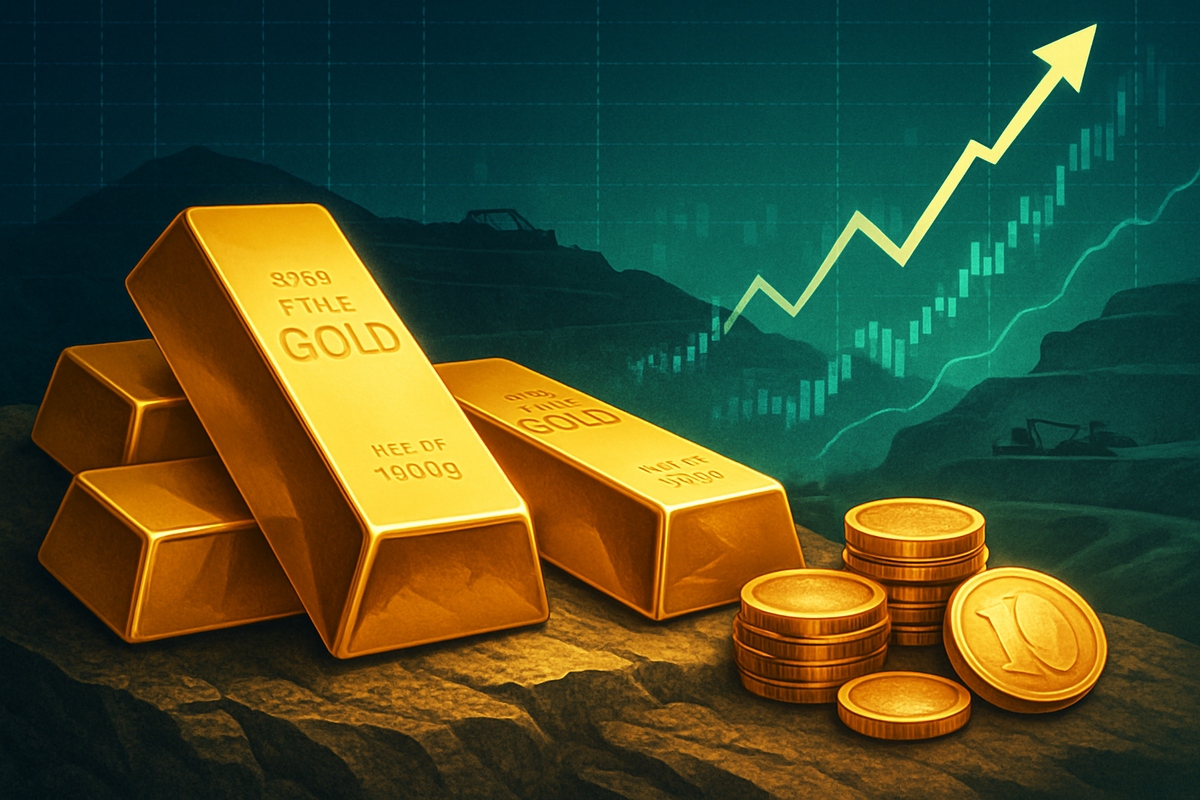
October 8, 2025 – Kinross Gold Corp (NYSE: KGC) has hit a new 52-week high of $25.83 USD, a significant milestone that perfectly encapsulates the current fervor sweeping through the global gold market. This surge positions Kinross Gold at the forefront of a historic rally that has seen the precious metal shatter all previous records, crossing the unprecedented $4,000 per ounce threshold today, October 8, 2025. The company's exceptional performance is not an isolated event but a clear reflection of broader macroeconomic shifts and escalating geopolitical uncertainties driving investors towards the perceived safety and enduring value of gold.
The immediate implications of this rally are profound, signaling robust profitability for gold miners and a renewed focus on precious metals as a hedge against inflation and instability. For Kinross Gold, achieving this peak indicates strong investor confidence in its operational efficiency and strategic positioning, allowing it to capitalize effectively on the elevated gold prices. The sustained upward trajectory of gold prices suggests a paradigm shift in investor sentiment, where traditional financial assets are being re-evaluated in favor of tangible stores of wealth amidst a complex global economic landscape.
Unpacking the Golden Ascent: A Timeline of Unprecedented Gains
Today, October 8, 2025, marks a pivotal moment in financial history as gold not only pushed Kinross Gold (NYSE: KGC) to its 52-week high but also breached the monumental $4,000 per ounce mark, reaching an all-time high of $4,049.52. This incredible ascent represents a gain of over 50% in 2025 alone, a rate of increase not witnessed since the tumultuous oil crisis of 1979. The journey to this peak has been a multi-year "super cycle" for gold, commencing in 2023 and steadily gathering momentum.
The timeline leading to this historic moment reveals a confluence of powerful drivers. In December 2023, gold prices initially reacted to new central bank monetary policies and rising safe-haven demand, hitting $2,071 per ounce. Early 2024 saw gold achieve its highest monthly average in February, surging over 45% throughout the year. By April 2025, the precious metal had catapulted to a record high of $3,500 per ounce, setting the stage for today's groundbreaking achievement.
Several interconnected factors have fueled this sustained gold rally. Persistent global inflation, with the U.S. rate stubbornly above the Federal Reserve's 2% target, has made gold an attractive hedge. Geopolitical tensions, including the ongoing U.S. government shutdown, a political crisis in France, and the lingering effects of Russia's 2022 invasion of Ukraine, have significantly amplified gold's safe-haven appeal. Central banks globally have been aggressively accumulating gold reserves, marking the fastest pace in modern history, driven by concerns over "dollar weaponization" and a strategic diversification away from traditional reserve currencies. Furthermore, the Federal Reserve's shift towards a more accommodative monetary policy, with multiple rate cuts initiated in mid-2024 and expected to continue, has reduced the opportunity cost of holding non-yielding assets like gold. A weaker U.S. dollar, down nearly 10% this year, has also made gold more affordable for international buyers, while increasing private investor demand, particularly through Exchange Traded Funds (ETFs), has provided the latest thrust to the rally.
Winners and Losers in the Golden Tide
The surging gold prices create a clear delineation between potential winners and losers in the financial markets. Unsurprisingly, gold mining companies stand to be the primary beneficiaries. Kinross Gold (NYSE: KGC), with its 52-week high and strong financial performance—reporting a 42% year-over-year revenue increase in Q2 2025 and adjusted net earnings more than tripling—is a prime example. Its year-to-date return of +168% significantly outpaces both the broader Zacks Mining – Gold industry and the VanEck Gold Miners ETF. This outperformance highlights the leveraged exposure that mining stocks offer to gold prices, amplifying returns as the metal rallies.
Other major gold producers like Barrick Gold (NYSE: GOLD) and Newmont (NYSE: NEM) are also poised for substantial gains. Higher gold prices directly translate to increased revenue and expanded profit margins for these companies, enabling them to boost exploration budgets, enhance shareholder returns through dividends or buybacks, and potentially reduce debt. Companies with efficient operations and lower all-in sustaining costs, such as Kinross, which reported costs around $1,300 per ounce, are particularly well-positioned to maximize profitability in this high-price environment. Junior exploration companies, while riskier, could also see increased investor interest and easier access to capital for new projects.
Conversely, some entities may face challenges. Industries or companies that rely heavily on gold as an input, such as certain luxury goods manufacturers or electronics firms, could experience increased raw material costs, potentially squeezing their margins or requiring them to pass on higher prices to consumers. Investors heavily weighted in assets typically seen as alternatives to gold, such as certain government bonds or growth stocks that thrive in stable, low-inflation environments, might see their portfolios underperform relative to gold-backed investments. While not direct "losers," these sectors may simply not capture the same upside momentum.
A Wider Lens: Gold's Role in a Shifting Global Economy
The current gold rally and Kinross Gold's (NYSE: KGC) stellar performance are not isolated market events but deeply embedded within broader global economic and geopolitical trends. This surge underscores a significant shift in investor psychology, moving away from purely growth-oriented strategies towards a greater emphasis on wealth preservation and hedging against systemic risks. The sustained demand for gold reflects widespread concerns about the long-term stability of fiat currencies, exacerbated by unprecedented levels of government debt and expansionary monetary policies globally.
The ripple effects of this gold surge extend beyond the mining sector. Central banks' aggressive gold accumulation signals a broader de-dollarization trend, as nations seek to diversify their reserves and reduce reliance on a single currency that could be subject to geopolitical weaponization. This could lead to a more multipolar global financial system over time. For competitors, the elevated gold prices present both opportunities and challenges; while all miners benefit, those with higher cost structures or less efficient operations might find it harder to compete with the likes of Kinross, which boasts strong operational metrics.
Regulatory and policy implications could also emerge. Increased mining activity, driven by higher prices, might intensify scrutiny on environmental and social governance (ESG) practices within the industry. Governments in resource-rich nations may also look to revise royalty structures or taxation policies to capture a larger share of the increased profits. Historically, periods of high inflation and geopolitical instability have almost always coincided with strong gold performance, as seen during the 1970s and early 2000s. The current environment mirrors these historical precedents, suggesting that gold's role as a safe haven remains as relevant as ever, if not more so, in the complex 21st-century global economy.
What Comes Next: Navigating the Golden Future
Looking ahead, the trajectory of gold prices and, by extension, gold mining stocks like Kinross Gold (NYSE: KGC) will largely depend on the persistence of the underlying drivers of the current rally. In the short term, continued geopolitical tensions, sustained inflation, and the Federal Reserve's accommodative monetary policy are likely to provide ongoing tailwinds for gold. Investors should watch for further central bank actions, inflation data releases, and any significant shifts in global political stability, as these will be key determinants of gold's immediate direction. The strong momentum suggests that gold could consolidate above the $4,000 mark, potentially setting new higher targets if current conditions persist.
In the long term, gold miners may engage in strategic pivots to capitalize on this environment. This could include increased capital expenditure on exploration and development to expand reserves, a focus on optimizing existing operations to further reduce costs and maximize margins, or even consolidation within the industry as larger players acquire smaller ones to enhance their portfolios. Companies like Kinross Gold, which have demonstrated robust operational performance, are well-positioned to pursue such growth strategies.
Market opportunities will likely emerge in related sectors, such as gold streaming and royalty companies, which offer diversified exposure to gold production without direct mining risks. Challenges may include potential supply responses from the mining industry, which could eventually moderate price increases, or a significant reversal in monetary policy if inflation is brought under control more rapidly than expected. Potential scenarios range from a continued "super cycle" where gold maintains its elevated status as a primary hedge, to a more subdued market if global conditions stabilize and central banks reverse course on their gold accumulation strategies. Investors should monitor commodity market dynamics, currency fluctuations, and global economic indicators closely.
The Enduring Allure: A Comprehensive Wrap-Up
The ascent of Kinross Gold (NYSE: KGC) to a 52-week high, coinciding with gold's historic breach of the $4,000 per ounce barrier, underscores a critical period in financial markets. The key takeaway is the precious metal's reassertion of its role as a fundamental safe-haven asset amidst a complex tapestry of persistent inflation, widespread geopolitical instability, aggressive central bank diversification, and dovish monetary policies. Kinross Gold's exceptional performance, characterized by strong revenue growth and increased earnings, exemplifies how well-managed mining companies can leverage high gold prices for significant shareholder value.
Moving forward, the market is poised for continued volatility, with gold likely to remain a cornerstone of diversified investment portfolios. Its recent performance suggests that the drivers are more structural than transient, hinting at a prolonged period of elevated demand.
The lasting impact of this event will likely be a re-evaluation of asset allocation strategies, with a greater emphasis on tangible assets and commodities. For investors, vigilance will be key. Monitoring inflation trends, the rhetoric and actions of central banks, and evolving geopolitical landscapes will provide crucial insights into gold's future trajectory. Furthermore, observing the strategic moves of leading gold miners like Kinross Gold—their exploration efforts, cost management, and capital allocation decisions—will offer valuable clues about the sustainability of their performance in this new golden era.
This content is intended for informational purposes only and is not financial advice.






